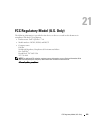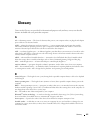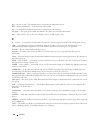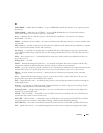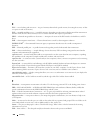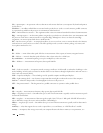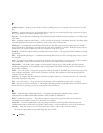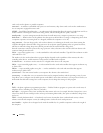
Glossary 365
• It is located on a network in a directory and the system administrator has assigned rights only to specific individuals.
refresh rate — The frequency, measured in Hz, at which your screen's horizontal lines are recharged (sometimes also
referred to as its vertical frequency). The higher the refresh rate, the less video flicker can be seen by the human eye.
resolution — The sharpness and clarity of an image produced by a printer or displayed on a monitor. The higher the
resolution, the sharper the image.
RFI — radio frequency interference — Interference that is generated at typical radio frequencies, in the range of 10 kHz
to 100,000 MHz. Radio frequencies are at the lower end of the electromagnetic frequency spectrum and are more likely to
have interference than the higher frequency radiations, such as infrared and light.
ROM — read-only memory — Memory that stores data and programs that cannot be deleted or written to by the
computer. ROM, unlike RAM, retains its contents after you shut down your computer. Some programs essential to the
operation of your computer reside in ROM.
RPM — revolutions per minute — The number of rotations that occur per minute. Hard drive speed is often measured in
rpm.
RTC — real time clock — Battery-powered clock on the system board that keeps the date and time after you shut down
the computer.
RTCRST — real-time clock reset — A jumper on the system board of some computers that can often be used for
troubleshooting problems.
S
SAS — serial attached SCSI — A faster, serial version of the SCSI interface (as opposed to the original SCSI parallel
architecture).
SATA — serial ATA — A faster, serial version of the ATA (IDE) interface.
ScanDisk — A Microsoft utility that checks files, folders, and the hard disk’s surface for errors. ScanDisk often runs when
you restart the computer after it has stopped responding.
SCSI — small computer system interface — A high-speed interface used to connect devices to a computer, such as hard
drives, CD drives, printers, and scanners. The SCSI can connect many devices using a single controller. Each device is
accessed by an individual identification number on the SCSI controller bus.
SDRAM — synchronous dynamic random-access memory — A type of DRAM that is synchronized with the optimal
clock speed of the processor.
serial connector — An I/O port often used to connect devices such as a handheld digital device or digital camera to your
computer.
Service Tag — A bar code label on your computer that identifies your computer when you access Dell Support at
support.dell.com or when you call Dell for customer service or technical support.
setup program — A program that is used to install and configure hardware and software. The setup.exe or install.exe
program comes with most Windows software packages. Setup program differs from system setup.
shortcut — An icon that provides quick access to frequently used programs, files, folders, and drives. When you place a
shortcut on your Windows desktop and double-click the icon, you can open its corresponding folder or file without having
to find it first. Shortcut icons do not change the location of files. If you delete a shortcut, the original file is not affected.
Also, you can rename a shortcut icon.
SIM — Subscriber Identity Module — A SIM card contains a microchip that encrypts voice and data transmissions. SIM





